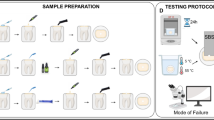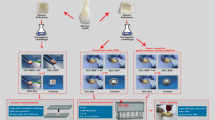Abstract
Objectives
The objective of this study was to evaluate the inhibition of demineralization around enamel-dentin/restoration interface after dentin pretreatment with 2.5 % titanium tetrafluoride (TiF4).
Materials and methods
Forty dental class V cavities at the cementoenamel junction were distributed into four groups (n = 10), according to the presence or absence of TiF4 and to the adhesive system (Clearfil SE Bond/CL and Adper EasyOne/AD), and restored with a resin composite. A dynamic pH cycling model was used to induce the development of artificial caries lesions. After sectioning the dental blocks, Knoop microhardness tests were performed at different depths (20, 40, and 60 μm from the occlusal margin of the restoration) and at different distances (100, 200, and 300 μm from the adhesive interface). Repeated measures three-way analysis of variance (ANOVA) and Tukey’s test were used (α = 0.05).
Results
For enamel, there were no differences in the microhardness values for CL, AD, and TiF4-AD at depths, regardless of the distances. Considering each depth, there were no significant differences among treatments. For dentin, ANOVA showed no significant interaction among the independent variables treatment*distance*depth (p = 0.994), no significant interaction between treatment*depth (p = 0.722), no significant interaction between treatment*distance (p = 0.265), no significant interaction between depth*distance (p = 0.365), and no significant effect on treatment (p = 0.151), depth (p = 0.067), or distance (p = 0.251).
Conclusions
Dentin pretreatment of the cavity walls with TiF4 before self-etching adhesive systems was not effective in inhibiting demineralization around the enamel-dentin/restoration interfaces.
Clinical relevance
The mechanism of incorporating fluoride in enamel and dentin of the cavity walls to inhibit demineralization around restorations seems ineffective when using TiF4 as a dentin pretreatment.

Similar content being viewed by others
References
Wei SH, Soboroff DM, Wefel JS (1976) Effects of titanium tetrafluoride on human enamel. J Dent Res 55:426–431
Tveit AB, Hals E, Isrenn R, Tøtdal B (1983) Highly acid SnF2 and TiF4 solutions. Effect on and chemical reaction with root dentin in vitro. Caries Res 17:412–418
Buyukyilmaz T, Ogaard B, Rolla G (1997) The resistance of titanium tetrafluoride-treated human enamel to strong hydrochloric acid. Eur J Oral Sci 105:473–477
Schlueter N, Ganss C, Mueller U, Klimek J (2007) Effect of titanium tetrafluoride and sodium fluoride on erosion progression in enamel and dentine in vitro. Caries Res 41:141–145
Hove LH, Young A, Tveit AB (2007) An in vitro study on the effect of TiF4 treatment against erosion by hydrochloric acid on pellicle-covered enamel. Caries Res 41:80–84
Magalhães AC, Kato MT, Rios D, Wiegand A, Attin T, Buzalaf MA (2008) The effect of an experimental 4 % TiF4 varnish compared to NaF varnishes and 4 % TiF4 solution on dental erosion in vitro. Caries Res 42:269–274
Magalhães AC, Rios D, Honório HM, Delbem AC, Buzalaf MA (2009) Effect of 4 % titanium tetrafluoride solution on the erosion of permanent and deciduous human enamel: an in situ/ex vivo study. J Appl Oral Sci 17:56–60
Magalhães AC, Comar LP, Rios D, Delbem AC, Buzalaf MA (2008) Effect of a 4 % titanium tetrafluoride (TiF4) varnish on demineralisation and remineralisation of bovine enamel in vitro. J Dent 36:158–162
Alcantara PCC, Alexandria AK, Souza IPR, Maia LC (2014) In situ effect of titanium tetrafluoride and sodium fluoride on artificially decayed human enamel. Braz Dent J 25:28–32
Chevitarese AB, Chevitarese O, Chevitarese L.M., Dutra PB (2004) Titanium penetration in human enamel after TiF4 application. J Clin Pediatr Dent 28:253–256
Exterkate RA, ten Cate JM (2007) Effects of a new titanium fluoride derivative on enamel de- and remineralization. Eur J Oral Sci 115:143–147
Vieira AM, Ruben JL, Bronkhorst EM, Huysmans MC (2011) In vitro reduction of dental erosion by low-concentration TiF4 solutions. Caries Res 45:142–147
Charvat J, Soremark R, Li J, Vacek J (1995) Titanium tetrafluoride for treatment of hypersensitive dentine. Swed Dent J 19:41–46
Sen BH, Büyükyilmaz T (1998) The effect of 4 % titanium tetrafluoride solution on root canal walls-a preliminary investigation. J Endod 24:239–243
Basting RT, Leme AA, Bridi EC, et al (2014) Nanomechanical properties, SEM and EDS microanalysis of dentin treated with 25 % titanium tetrafluoride, before and after an erosive challenge. J Biomed Mater Res B Appl Biomater 11. doi:10.1002/jbm.b.33254
Kazemi RB, Sen BH, Spångberg LS (1999) Permeability changes of dentine treated with titanium tetrafluoride. J Dent 27:531–538
Calabria M, Porfirio R, Fernandes S, et al (2014) Comparative in vitro effect of TiF4 to NaF and potassium oxalate on reduction of dentin hydraulic conductance. Oper Dent 39:427–432
Dündar M, Ozcan M, Cömlekoglu ME, Sen BH (2011) Nanoleakage inhibition within hybrid layer using new protective chemicals and their effect on adhesion. J Dent Res 90:93–98
Devabhaktuni S, Manjunath M (2011) Effect of 4 % titanium tetrafluoride application on shear bond strength of composite resin: an in vitro study. J Conserv Dent 14:43–45
Bridi EC, Amaral FLB, França FMG, Turssi CP, Basting RT (2013) Influence of dentin pretreatment with titanium tetrafluoride and self-etching adhesive systems on microtensile bond strength. Am J Dent 26:121–126
Domingues LG, Real CM, Bridi EC, et al (2014) Effects of 2.5 % TiF4 on microtensile bond strength: influence of application method and degree of dentin mineralization. Int J Adhes Adhes 54:159–164
Tranquilin JB, Bridi EC, Amaral FL, et al (2015) TiF4 improves microtensile bond strength to dentin when using an adhesive system regardless of primer/bond application timing and method. Clin Oral Investig 31 In press
Itota T, Nakabo S, Iwai Y, Konishi N, Nagamine M, Torii Y (2002) Inhibition of artificial secondary caries by fluoride-releasing adhesives on root dentin. J Oral Rehabil 29:523–527
Peris AR, Mitsui FH, Lobo MM, Bedran-Russo AK, Marchi GM (2007) Adhesive systems and secondary caries formation: assessment of dentin bond strength, caries lesions depth and fluoride release. Dent Mater 23:308–316
Pedrosa VO, Flório FM, Turssi CP, Amaral FL, Basting RT, França FM (2012) Influence of pH cycling on the microtensile bond strength of self-etching adhesives containing MDPB and fluoride to dentin and microhardness of enamel and dentin adjacent to restorations. J Adhes Dent 14:525–534
Han L, Edward C, Okamoto A, Iwaku MA (2002) A comparative study of fluoride-releasing adhesive resin materials. Dent Mater J 21:9–19
Nakajima M, Okuda M, Ogata M, Pereira PNR, Tagami J, Pashley DH (2003) The durability of a fluoride-releasing resin adhesive system to dentin. Oper Dent 28:186–192
Tsuchiya S, Nikaido T, Sonoda H, Foxton RM, Tagami J (2004) Ultrastructure of the dentin-adhesive interface after acid-base challenge. J Adhes Dent 6:183–190
da Silva BM, França FM, Flório FM, Basting RT (2010) In situ anticariogenic effect of adhesive systems containing fluoride and MDPB. Am J Dent 23:75–80
Featherstone JDB, O’Really MM, Shariati M, Brugler S (1986) Enhancement of remineralization in vitro and in vivo. In: Leach AS (ed) Factors relating to demineralization and remineralization of the teeth. IRL, Oxford
Serra MC, Cury JA (1992) The in vitro effect of glass-ionomer cement restoration on enamel subjected to a demineralization and remineralization model. Quintessence Int 23:143–147
Cenci MS, Pereira-Cenci T, Cury JA, Ten Cate JM (2009) Relationship between gap size and dentine secondary caries formation assessed in a microcosm biofilm model. Caries Res 43:97–102
Diercke K, Lussi A, Kersten T, Seemann R (2009) Isolated development of inner (wall) caries like lesions in a bacterial-based in vitro model. Clin Oral Investig 13:439–444
Savarino L, Breschi L, Tedaldi M, et al (2004) Ability of restorative and fluoride releasing materials to prevent marginal dentine demineralization. Biomaterials 25:1011–1017
Belli R, Kreppel S, Petschelt A, Hornberger H, Boccaccini AR, Lohbauer U (2014) Strengthening of dental adhesives via particle reinforcement. J Mech Behav Biomed Mater 37:100–108
Shinkai RS, Cury AA, Cury JA (2001) In vitro evaluation of secondary caries development in enamel and root dentin around luted metallic restoration. Oper Dent 26:52–59
Ten Cate JM (1999) Current concepts on the theories of the mechanism of action of fluoride. Acta Odontol Scand 57:325–329
White DJ (1995) The application of in vitro models to research on demineralization and remineralization of the teeth. Adv Dent Res 9:175–193
Cury JA, Rebelo MA, Del Bel Cury AA, Derbyshire MT, Tabchoury CP (2000) Biochemical composition and cariogenicity of dental plaque formed in the presence of sucrose or glucose and fructose. Caries Res 34:491–497
Skartveit L, Gjerdet NR, Selvig KA (1991) Release of fluoride and metal ions from root surfaces after topical application of TiF4, SnF2, and NaF in vitro. Acta Odontol Scand 49:127–131
Wiegand A, Magalhães AC, Sener B, Waldheim E, Attin T (2009) TiF(4) and NaF at pH 1.2 but not at pH 3.5 are able to reduce dentin erosion. Arch Oral Biol 54:790–795
Clarkson B, Wefel J (1979) Titanium and fluoride concentrations in titanium tetrafluoride and APF treated enamel. J Dent Res 58:600–603
Wiegand A, Waldheim E, Sener B, Magalhães AC, Attin T (2009) Comparison of the effects of TiF4 and NaF solutions at pH 1.2 and 3.5 on enamel erosion in vitro. Caries Res 43:269–277
Bridi EC, Amaral FLB, França FMG, Turssi CP, Flório FM, Basting RT (2015) In vitro effects of 2.5 % titanium tetrafluoride on Streptococcus mutans and Lactobacillus casei in dentin, followed by self-etching adhesive systems. Eur J Prosthodont Rest Dent 23. In press.
Nassur C, Alexandria AK, Pomarico L, de Sousa VP, Cabral LM, Maia LC (2013) Characterization of a new TiF4 and beta-cyclodextrin inclusion complex and its in vitro evaluation on inhibiting enamel demineralization. Arch Oral Biol 58:239–247
Acknowledgments
The authors would like to thank FAPESP foundation for providing grants (process number 2011/02812-7).
Conflict of interest
The authors declare that they have no competing interests.
Disclosure statement
The authors have no financial, economic, commercial, and/or professional interests related to topics presented in the manuscript.
Author information
Authors and Affiliations
Corresponding author
Rights and permissions
About this article
Cite this article
Bridi, E.C., do Amaral, F.L.B., França, F.M.G. et al. Inhibition of demineralization around the enamel-dentin/restoration interface after dentin pretreatment with TiF4 and self-etching adhesive systems. Clin Oral Invest 20, 857–863 (2016). https://doi.org/10.1007/s00784-015-1573-6
Received:
Accepted:
Published:
Issue Date:
DOI: https://doi.org/10.1007/s00784-015-1573-6




